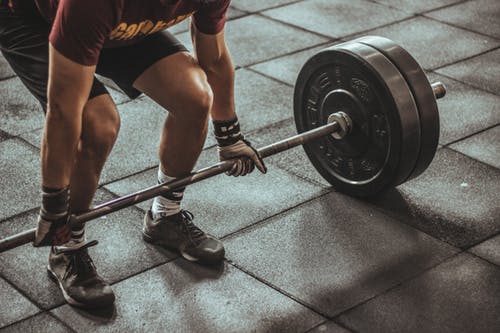The deadlift is a popular exercise in strength and conditioning. It is a total body exercise that involves exerting force against the ground while the athlete stands up with heavy weights in their hands. While it develops great strength, the argument has been that the deadlift is a slow exercise so it may not be appropriate for athletes that need to be able to move explosively.
Some coaches have suggested that adding chains to a deadlift will help to improve an athlete’s explosiveness. In 2011, Swinton et al studied this using powerlifters and rugby players. The authors studied their subjects over several days with several conditions of the deadlift and recorded kinematic and kinetic data about the lifts under each condition.
Their subjects began the study by performing a 1RM on the deadlift. Then there were several testing conditions:
- Subjects performed maximum velocity lifts with 30, 50 and 70% of 1-RM
- Subjects performed submaximal velocity lifts with 30, 50, and 70% of 1-RM
- Subjects performed maximal velocity lifts 20% and 40% of 1-RM added to the barbell in chains. When this was done subjects performed lifts with 20, 40, and 60% of 1-RM (for the 20% chains) and 10, 30, and 50% of 1-RM (for the 40% chains) in weight plates in addition to the chains.
- Two repetitions were performed at each of these trials.
Results:
- The inclusion of chains significantly increased peak force and impulse but decreased average velocity, peak velocity, average power, peak power and peak rate of force development.
- The inclusion of chains allowed for greater force to be maintained during the latter parts of the lift.
- Looking at the kinematic data for the non chain
lifts was interesting:
- Repetitions take longer as the weight on the bar increases. Max velocity repetitions happened faster than submaximal velocity reps.
- Peak force was greatest for maximal velocity reps.
- Average and peak velocity were greatest on maximal velocity reps, on those as the weight increased the velocity decreased.
- Peak power was greatest for the maximal velocity reps, as the weight increased the peak power decreased.
- The peak rate of force development was greatest for maximal velocity reps, as the weight increased so did the rate of force development.
- The addition of chains increased peak force but decreased peak velocity, peak power, and peak rate of force development.
As you would expect, it takes longer to lift heavier weights. Trying to move the bar explosively results in a faster, more explosive lift. Heavier weights mean a slower lift which negatively impacts power. Chains have a negative impact on velocity, power, and rate of force development but allow for force to be maintained through more of the lift.
A lot of this information is pretty logical. However, this study had one interesting piece of data. In this study, the authors reported power outputs of the deadlift, at 70% of maximum and attempting to pull at maximum velocity, to be over 11,000 watts. That greatly exceeds the values reported for the Olympic lifts. For example, in “Power production by Olympic weightlifters” Garhammer reports values of close to 4800 watts in the jerk and second pull of the snatch. Even the submaximal reps at 30% of 1-RM had power outputs of almost 4900 watts (and this was the lowest power output)! This brings into question the assumption that athletes should not deadlift, I’m going to argue that it’s an important exercise to include in an athlete’s strength and conditioning program.
References:
Garhammer, J. (1980). Power production by Olympic weightlifters. Medicine and Science in Sports and Exercise, 12(1): 54-60.
Swinton, P.A., Stewart, A.D., Keogh, J.W.L., Agouris, I., and Lloyd, R. (2011). Kinematic and kinetic analysis of maximal velocity deadlifts performed with and without the inclusion of chain resistance. Journal of Strength and Conditioning Research, 25(11): 3163-3174.



